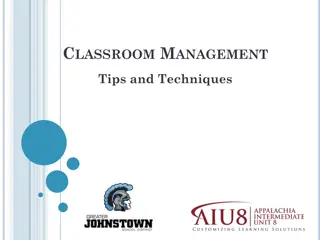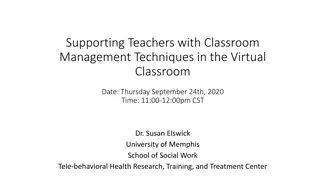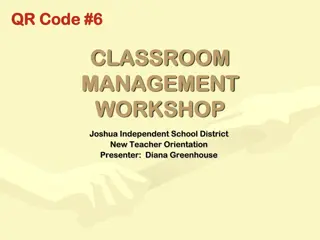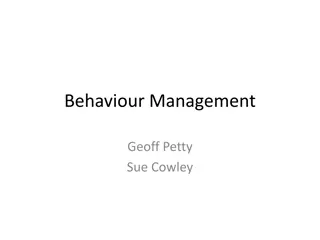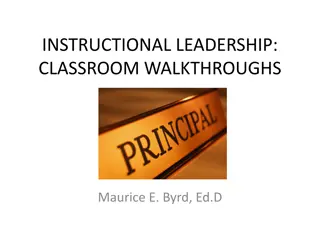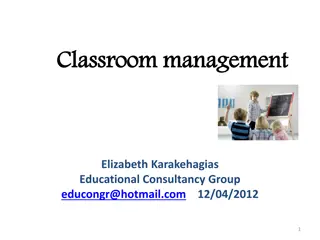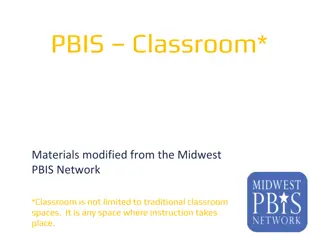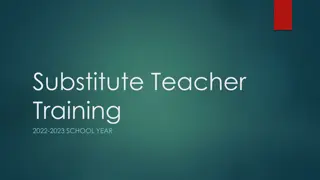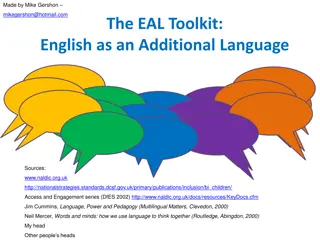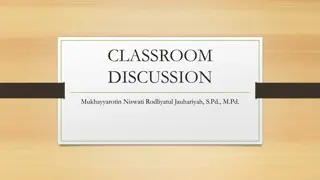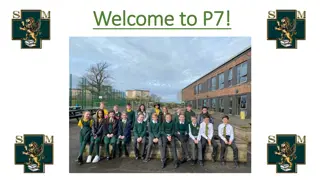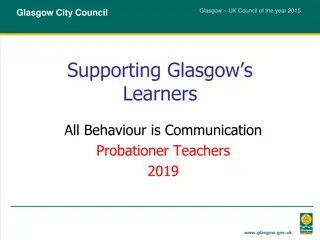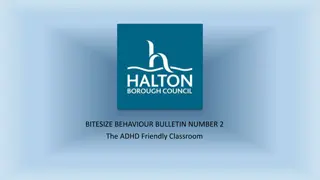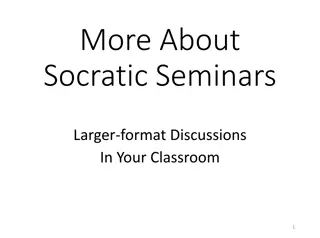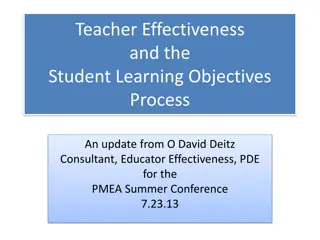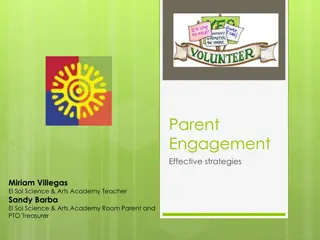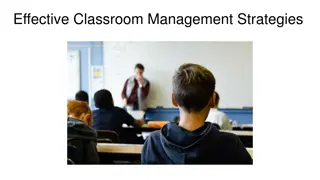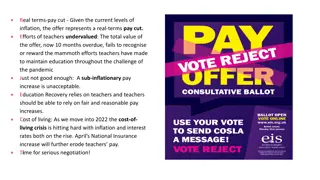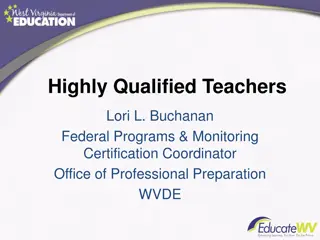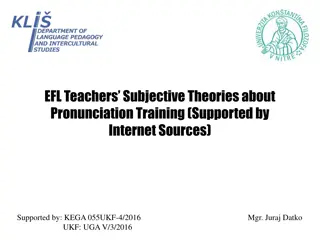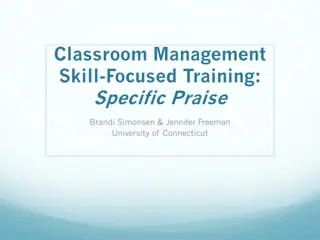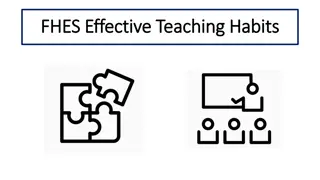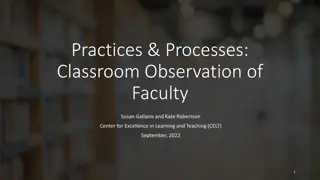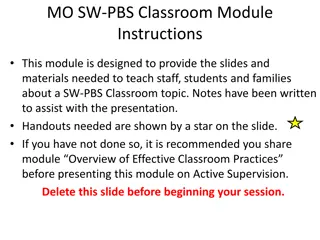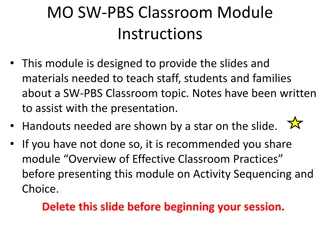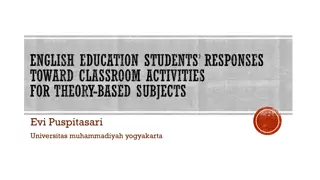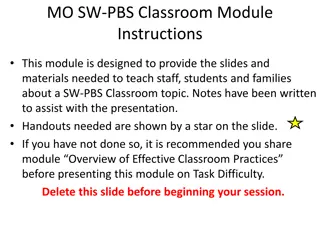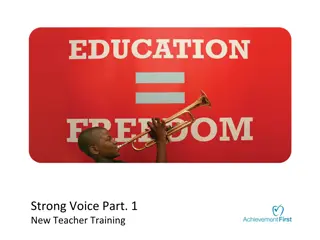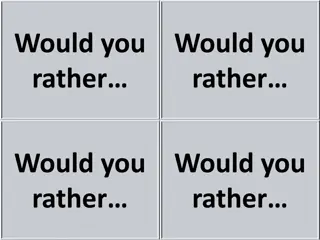Effective Classroom Management Strategies for Teachers
Develop strong routines in the classroom to create a positive learning environment. Start with a warm meet-and-greet routine to set the tone for the day. Clearly communicate and enforce your expectations for behavior. Consistency in teaching routines will lead to a well-managed classroom where learning can thrive.
Download Presentation

Please find below an Image/Link to download the presentation.
The content on the website is provided AS IS for your information and personal use only. It may not be sold, licensed, or shared on other websites without obtaining consent from the author. Download presentation by click this link. If you encounter any issues during the download, it is possible that the publisher has removed the file from their server.
E N D
Presentation Transcript
Mastery A Training Guideline for Developing Routines in the Classroom
Meet and Greet Meet and Greet Elbow greet and air high five every learner before entry into your class in the morning at school and start showing how pleased you are to see them Purpose It make them feel appreciated before they've even walked into your classroom, and you have every chance of having a lesson that is calm, and well-disciplined and well- managed In the first few minutes you are meeting, greeting, smiling, bumping elbows, being pleased to see them, (yes, even those who you might rather had stayed at home!)
You are marking the line between their social lives and the learning, between informality and formality Early Early intervention is intervention is at the door at the door First impressions count It s YOU that can help them feel important, valued and appreciated before they even enter the room
TONE Your non-verbal behaviours and words you use are crucial when creating the atmosphere conducive to learning. Smiling, friendly eye contact and open hand gestures lay the foundations for your tone of voice and words and phrases that follow. Good Mornings Thanks for being on Time Uniform is looking good Hello, it s a lovely day
Routines you expect learners to follow Routines you expect learners to follow Learners need to have YOUR expectations for learning clearly explained and displayed prominently. It is not sufficient to assume or expect that learners know how to behave for you. To manage and improve behaviour you need to TEACH it. Don t allow your learners to guess the rules for each activity or to simply adopt the same behaviours as they do in other subjects. When the RULES for each type of activity (watching a demonstration, silent independent work, packing away at the end) are clear to everyone, then the boundaries for conduct are properly set.
Context: It takes time to teach the routines Context: It takes time to teach the routines It start off as checklists that are run through laboriously before each new activity but when the learners have learned them well the signs disappear, the acknowledgement becomes discreet and a routine becomes automated.
Task Task Your Routines Your Routines Spend five minutes to write down all the formal routines you expect learners to follow. e.g. answering registers, watching a demonstration, peer assessment feedback, operating class resources (puzzles, paint, clay,) Then spend five minutes writing down all the informal routines you expect. e.g. packing away books, staying safe in the class, asking for permission to leave the room
Structuring Classroom Routines Structuring Classroom Routines Signs and Symbols Signs and Symbols Learners read signs quicker than they read your intent or remember your voice. The digital child is icon intelligent. Signs and symbols guide them through new media and technology. Learners use icons to plot their map of new worlds and new routines. Using them in the classroom means you can teach complex routines and have clear reminders displayed. agree on a set of icons to represent the steps Leave the icons on display near the activity.
Signs Signs The signs you agree with the group help to focus the learners on the behaviours that you need to see. They must be positive, affirming and engaging. Before embarking on a new activity establish the routine, draw it, display it and refer to it continually. When the activity begins, focus on those learners who are following the rules use acknowledgement and recognition to support their good choices: Thank you, this table; you have stopped your conversations, got your pens out and are listening. That is number two on our agreement.
ICONS ICONS When all the adults sing from the same song sheet the learner shouting is met with the same response. Without this level of agreement a single behaviour can be addressed in many different ways by different adults. Mixed messages mean new behaviours take longer to learn. The consistency and repetition are essential as old habits are replaced with new behaviours. The consistency is further embedded as you use the icons in your non-verbal language. With the icons on display they can be used to indicate subtly to learners, as a backdrop for a conversation about behaviour or as a focus for the learners attention.
Develop Behaviour Icons for the following Routines Icons Iconsencourage your learners to recall rules quickly and easily. Use them to display rules and expectations, as rule reminders for individuals, to manage low level disruption, as reward slips for certain behaviours, as visual targets for individuals on report and to make good behaviour look groovy. The icons can work particularly well with learners who appreciate visual cues, particularly learners with ADHD. Stay on task Be ready to learn Follow instructions Keep hands and feet to yourself One voice at a time Phones on silent Share Speak politely
Dont wait until poor habits become second nature before you try to intervene. Teach every learner precisely how to treat you, how to treat others and how to treat the resources. Learners like routines. The world is more consistent, more predictable and feels safer with routines. For learners with behaviour related conditions, ADHD, Asperger s, Autism the icons are essential hooks. They must be clear and impossible to misinterpret. Teach routines from the start. You might try using photographs of the learners demonstrating the behaviours that you want to see as your symbols. Reduce the symbols to stamp size and they can also be presented and collected. Through the ritual of reinforcement the routine is kept at the forefront of the fast paced mind of the learner.
Watch out for Watch out for Displaying the rules on just one wall or in one place Think about where your routines are best displayed. A checklist of rules for entering and leaving the room should be on the door. Similarly, the routines for individual table activities need to be visible to everyone as they work. Enthusiastically introducing rituals and then not referring to them again until sanctions need to be applied. Use the routines to support your discussions with learners. Refer to them tirelessly until they realise that you are not going to be diverted from them.
Establishing too many new rituals too soon. Introduce new routines gradually and over time. Allow one or two to become embedded before developing more advanced routines. Too many new routines too soon are confusing for learners and teachers. Watch out for Watch out for
Reminder for Routine Writing Reminder for Routine Writing Avoid use of No and Don t - they have no positive impact on the routine Phrase routines positively Keep your checklist to a maximum of five and preferably limit to three Describe the behaviour that you need to see not the state of mind of the learner
Task: Creating routines Task: Creating routines Create Create the following three essential routines for your teaching space. Routine for latecomers Routine for individual work Routine for practical work Be specific about what behaviours you want to see. Give clear instructions for learners to follow in these specific situations.
When they are late, are they allowed to enter the room straight away? Do they go straight to their seat or somewhere else? What do they say to you? What do you say to them? At what point are they integrated within the classwork? What consequences are there for being late? For example, For example, Routine 1 Routine 1 When you have created your three routines, choose one to work up into a series of illustrated icons - a poster that you can refer to when teaching, embedding, reinforcing and referring to the routine.
Routine for small group discussion Allocate roles to each person in the group - chair, timekeeper, note-taker etc. Everyone has one minute to speak in turn - they put their own ideas, points of view, questions to the group. As a group agree on three ideas, three arguments or issues and three questions you want to ask. Examples for Examples for routine 2 routine 2
Routine for leaving the classroom Stay on task until the verbal cue from the teacher (even if the bell rings). Clear your desk thoroughly. Check the board for homework. Sit down to show you are ready to leave. Calmly leave the room when asked to by the teacher. Examples for Examples for routine 3 routine 3
A simple routine for group work Examples for Examples for routine 4 routine 4 One voice at a time. Take notes. Be kind.
Reflect on your rules and find out the views of your learners. Your rules and Your rules and your learners' your learners' views on them views on them Reflection What rules operate in your teaching space? Take five minutes to think about it and write down all the rules you can. Include: Whole school rules, additional rules for your teaching space, rules for practical work, health and safety rules, rules about equipment etc.
Ask at least five learners from different classes the following four questions: Task on Task on Reflections Reflections What do you think the rules are? What is the rule that is the most important to the teacher in this room? What happens when you break the rules? What happens when you follow the rules? Note down what the learners have said.
Discuss Discuss What do you learn from this activity? Share your thoughts about what the responses were and what you have learnt from this activity in this discussion. Please remember not to mention individuals, schools or other organisations by name. Please respect others confidentiality and privacy at all times.
When you create rules and routines, decide on the precise behaviours that you expect from your learners; agree a short checklist of 3-5 points. Consider using Follow instructions first time given as your first and most important step. Do not negotiate rules, routines and rituals until you are confident that such discussions will be a productive use of time. You may decide to investigate rules and routines that operate successfully in other classrooms and build on these (this is particularly useful if you are new to the school or when you are taking over the class from a colleague). Creating rules and Creating rules and routines routines
Use positive language when drafting rules and routines; identify the behaviours that you want to see rather than those which you don t want. Remember Remember
Introduce new routines gradually, teach one or two until the learners complain, Alright, enough already! We know the routine! Teach the learners your routines for formal learning activities (independent work, group discussion, think/pair/share etc) and teach the learners your rituals for classroom organisation and informal activities (entering the classroom, tidying, answering questions). Embedding rules and Embedding rules and routines routines
Visual Display It is worth keeping the rules and routines of your classroom clearly on display on large sheets of paper on at least two walls of the classroom; use words, pictures and symbols on the signs. You can involve the learners in making, positioning and updating the signs. Consider the position of the rules/routines signage carefully. When a visitor comes into your room it should be absolutely clear what rules and routines are in place. With signs to point to, it is easy to remind the learners about the routine before you initiate a new task.
Use acknowledgement and positive reinforcement to embed your rules and routines. If learners decide not to follow the rules/routines, you can use redirection and then graduated sanctions to provide consequences (more about this later). Remember Remember
Take care not to introduce rules and routines and then forget to use them when managing behaviour, once established, keep referring to them, be boring about it! It will help you as well as the learners, as having clearly defined rules and routines will help you to remain consistent on difficult days. You can refer to the rules/routines signs when subtly redirecting behaviour or draw a learner over to the display to discuss your specific expectations. Establishing consistent practice Establishing consistent practice
learners feel safe and secure in classrooms that are predictable. Remember Young people like to know what to expect. They love routine.
Three is the magic number Most schools have so many rules even the people who wrote them cannot remember them! There are rules for health and safety that overlap with rules for classroom conduct, rules for movement that affect rules for groupwork. With the best of intentions, teachers tend to over do the rules. Three rules are better than thirty Three rules are better than thirty
What if we limit sets of rules or What if we limit sets of rules or routines to just routines to just three three steps? steps? Make them simple to recall, so that they are referred to more frequently and consistently by all adults Try simplifying your classroom expectations into sets of three so that even the most misty eyed learners know what is important in this room. Remember When framing rules, less is most definitely more!
Sometimes learners only get to know your rules when things go wrong and they hear them from you. They need to know the simple rules; those that support your routines and help you teach them how to treat you. Everybody wins. Wording and Wording and framing rules framing rules Create a poster of your three rules to display in your teaching space.
TIP Sheet: Habits of effective behaviour management TIP Sheet: Habits of effective behaviour management Meet and greet at the door - the best early intervention in behaviour management is at the door. Catch learners doing the right thing - nobody wants insincere praise and it can be easy to catch children doing the wrong thing so develop the ability to catch those more challenging learners doing the right thing. Deal with poor behaviour privately and calmly - avoid as much as possible the public humiliation or public sanctioning of learners Relentlessly build mutual trust - the relationship you have with learners sustains you and carries on into the future. Directly teach the behaviours and learning attitudes you want to see - have a plan so that you know the behaviours you are trying to teach and the learners know what behaviours they are trying to learn. Talk about values - never talk about behaviours in isolation - always relate them back to the culture you are trying to build and the values and truths you have as a class and as a teacher. Follow up follow up follow up - teachers who follow up are the ones the children decide to behave differently for. Write it down if you have a difficult incident with a learner, then you have the control back - you can decide when and how to follow up.
SUMMARY: Routines with learners SUMMARY: Routines with learners The routines you set up are like the subconscious act of breathing Define a simple routine for your teaching space with your learners Phrase it positively Make it your focus for the whole week, displaying it on the wall or board Establish it immediately by catching learners every time they follow the routine and have a private word with those who don t By the end of the week when the learners are fed up of you reminding them about it, you know the job is done Then onto the next one.
CONCLUSION CONCLUSION Remember use routines to achieve consistency in behaviour



